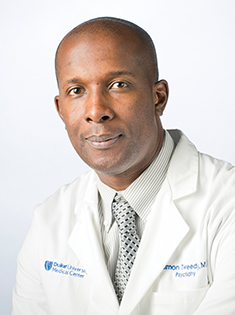Damon Tweedy ’96, biological science, graduated from UMBC in 1996 with a 4.0 grade point average – the first participant in the Meyerhoff Scholars Program to achieve that mark. And when he entered Duke Medical School, he excelled in the classroom there as well.
But when Tweedy began his clinical rotations and his residency after taking his M.D., he faced the task of translating that knowledge into effective care for real human beings. He also found his transition carried special challenges. He was one of the few African American students in his medical-school cohort, and he was training in a state with enormous racial, class, and regional disparities in health care access. Patients turned to Tweedy with expectations – and occasional open hostility – that his non-black colleagues didn’t experience.
Tweedy’s bestselling book, Black Man in a White Coat: A Doctor’s Reflections on Race and Medicine (Picador, 2015), subtly explores several types of bias commonly experienced by both patients and health professionals.
“One of the first things I noticed in residency was the custom of naming patients’ races when they’re presented in rounds,” says Tweedy, who is now an assistant professor of psychiatry at Duke. “‘So-and-so is a 55-year-old African American male.’ I thought: Why mention race? Occasionally it’s genuinely significant, but often it seems that the patient gets typecast before you even get to the rest of the story.”
Tweedy was raised in a working-class suburb of Washington, D.C., where his father worked as a grocery-store meat cutter for many years. UMBC recruited Tweedy on two fronts. First, he was spotted by UMBC President Freeman A. Hrabowski, III in the science-and-mathematics magnet program at Eleanor Roosevelt High School in Greenbelt. But he was also on the radar of the university’s basketball coaches.
“When I visited campus,” Tweedy recalls, “I got to know other current and prospective Meyerhoff students. I just remember that for so many years I’d felt out of place – being an African-American student who was doing well in science and math – and feeling like here at UMBC there was a space where I could be myself and succeed.”
Earnestine Baker, who directed the Meyerhoff program after Hrabowski became UMBC’s president, remembers Tweedy as a compelling student in the program’s early years.
“Damon had a quiet demeanor,” Baker says. “But he had this spark about him that made you want to know him, and to know more about him.” She recalls long conversations when Tweedy made the decision to leave the basketball team after his sophomore year. He realized that he had a chance at graduating with a perfect GPA, and he didn’t want anything to distract from that goal.
“One of the great things about the Meyerhoff program,” Tweedy says, “was that they not only paid close attention to how you were doing in the classroom, but they also encouraged you to get into summer research programs, to get exposed to people in the field and to the life of the laboratory.”
One summer placement in a National Institute on Aging lab in Baltimore led Tweedy to consider medical school. “One of the researchers there was a cardiologist who had trained at Johns Hopkins,” Tweedy says. “That was one of the first times I’d met a young male African-American physician…. He kind of took me under his wing, and he introduced me to other doctors and med students. The idea of becoming a doctor was really foreign to me. In terms of knowing people in my own life who’d traveled that road, I had no frame of reference at all.”
At Duke, Tweedy gravitated toward psychiatry, a field with acute disparities in access to care. “Depending on your insurance,” he says, “you might have access to 30 days of inpatient treatment, or you might have access to two days.”
Today Tweedy divides his time between clinical practice at Durham’s Veterans Affairs hospital and training medical students and residents at Duke. He leads a course for first-year students on the doctor-patient relationship, and tries to draw students’ attention to the many kinds of conscious and unconscious bias that can complicate that relationship.
“I try not to beat them over the head with it,” Tweedy says. “But I try to show them the subtle ways in which these issues can come up in different encounters. You may have all the knowledge in the world, but if you can’t communicate with the patient and understand where they’re coming from, you really can’t deliver optimal care.”
—David Glenn
Tags: Damon Tweedy, meyerhoff, Summer 2016

